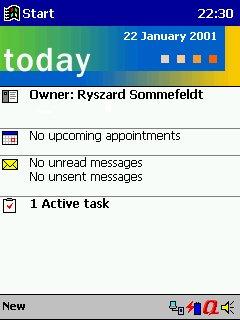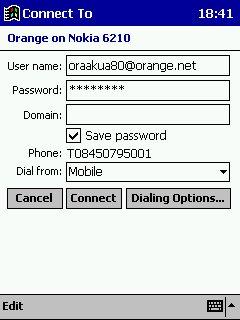What do you get?
WindowsCE & Bundled SoftwareThe iPAQ uses Microsoft's latest version of its WindowsCE operating system, version 3.0. This version addresses many of the usability problems associated with previous versions of the OS. It now sports a much cleaner user interface, with Microsoft choosing not to duplicate the regular Win32 version of the Windows GUI. Instead, the interface is more suited to the small devices that CE usually runs on.
With a flatter look, this version of CE is more responsive and easier on the eye, which is always welcome while running on devices with small, low resolution screens.
While my personal experience with previous versions of CE is limited, I do notice the difference. This version of CE is a pleasure to use.
To aid the usability, Microsoft provide you with a number of excellent input methods, to help you get the most out of the device and be as productive as possible.
Depending on the device, you may have a traditional keyboard to use as input, like on the insert device name. However, on the iPAQ and similar PDA's, you are given the following input methods.
Firstly, the operating system provides you with a virtual keyboard with which to tap out whatever you require to input. You can toggle its visibility easily to get the most screen real estate (maximised, it takes up approximately 1/4 of the screen on the iPAQ). Using this method of input, tapping at the screen using the stylus, you can achieve a high words-per-minute rate.
This is helped immensely by a terrific implementation of IntelliSense technology. During text entry, if CE recognises the first part of the word you are entering, it offers up a list of likely words that it thinks you might be entering. Clicking on the word required completes the word in a single tap. It's fully configurable with the user able to choose the number of words offered (between 1 and 4) and the number of letters before if offers you the choices. If it cannot offer you the correct word, carry on with your input and it will adjust the choices depending on the characters entered.
This greatly increases the speed with which you are able to enter text. With a little practise, you can become very proficient at entering text on devices such as the iPAQ.
Secondly, CE allows you to input using character recognition. An area the same size as the virtual keyboard is displayed with 3 sections, one for capital letters, one for lower case letters and one for numbers.
Writing on the required area lets the Operating System attempt to recognise the character you are trying to input. There are some concessions to be made in comparison to natural writing style. You are limited to entering characters individually, rather than writing joined. To assist in reducing the speed loss that limitation causes, you are given a number of excellent tools.
Again, IntelliSense is used to predict what you are entering. Secondly, a number of simple stylus strokes can be used instead of tapping the common extra keys offered to the right of the 3 text input areas, such as space, enter, shift and backspace.
Dragging the stylus from left to right in the input area like you would do if entering a hyphen, causes a space to be inserted. You are forced to use the right hand side menu to enter a hyphen, but the number of times you enter the space character far outweighs the number of times a hyphen is entered and is a good trade-off which allows you to continue entering text without breaking your rhythm.
It takes more practice to become proficient at entering text using the character recognition, but the benefits are clear, since writing is far more natural than stabbing at a virtual keyboard!
Again, you can easily toggle on and off the area set aside for the recognition area giving you maximum screen real estate with which to view your work.
Program wise, the iPAQ ships with a good range of software. Essentials like Pocket Word, Excel, Internet Explorer and Money are all present. You also get the acclaimed Microsoft Reader, which contains ClearType technology to enable the easy reading of text on devices like the iPAQ with a small screen.
Rounding off the software bundle we have the Windows Media Player, letting you use the iPAQ as a portable MP3 and WMA player (more on that later). Finally, Compaq supply a suite of useful utilities called QUtilities giving you quick access to common functions from a menu activated by tapping the Q menu on the screen (if you have them loaded) or by pressing the dedicated Q button on the iPAQ itself.
On the PC side of things, you get the latest build of the ActiveSync software and a copy of Outlook 2000. ActiveSync integrates nicely with Outlook 2000 to provide constant synchronisation of your email, contacts, tasks and calendar. Pop the iPAQ into its cradle and ActiveSync wakes up and checks for changes on the iPAQ and Outlook and synchronises between the two.
ActiveSync is also used to Add/Remove programs from the iPAQ and explore the device from your PC. The current build of ActiveSync is very good and works very well. Previous versions had a few problems but the program is now mature. Moving a document to and from the iPAQ causes ActiveSync to convert the document between normal and pocket formats on the fly.




